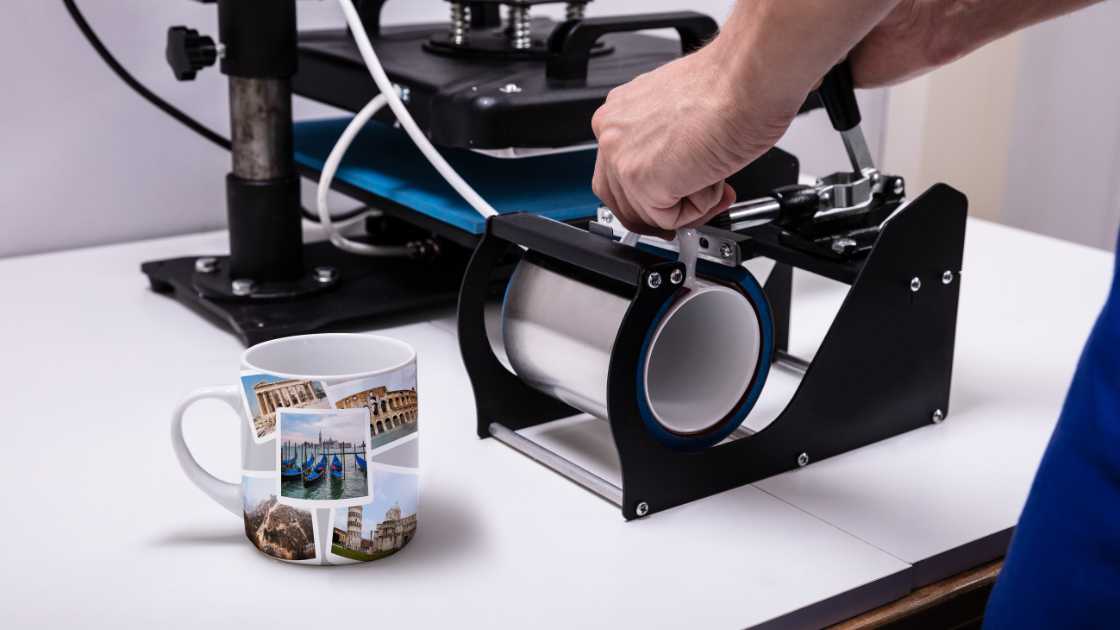Sublimation mugs fade due to insufficient time, temperature, or pressure during the printing process. To solve this, adjust these factors according to the mug’s material and the sublimation ink’s requirements.
Creating personalized mugs through sublimation is a popular way to add a personal touch to your morning coffee routine. Achieving vibrant, lasting colors is key, but sometimes these custom designs can lose their luster, leading to faded images that lack the initial visual punch.
The Science Of Sublimation On Mugs
Imagine seeing a bright, vivid image on a mug, only for it to fade away with time. The science behind sublimation on mugs is key to preventing this disappointment.
Let’s sink into what sublimation printing is and how to keep those designs lasting longer.
Basics Of Sublimation Printing
Sublimation printing transfers a design from paper onto a mug through heat and pressure. The ink turns into gas, bonds to the mug’s surface, and solidifies.
This creates durable, high-quality images on your mugs. Here’s how it works:
- Digital Image: A design is printed onto special sublimation paper using sublimation ink.
- Heat Press: The paper is pressed against the mug’s surface.
- High Temperature: Heat transforms the ink into a gas that permeates the mug.
- Cooled Down: The gas reverts to a solid state, with the design permanently embedded.
Why Mug Designs Fade Over Time

Despite the robust process, mug designs can fade. Here are the main reasons:
- Quality of Ink: Low-quality inks may not adhere well.
- Mug Quality: Poor coating on mugs leads to poor sublimation.
- Dishwasher Use: Harsh detergents and high heat can degrade the image.
- UV Exposure: Prolonged sunlight exposure fades colors over time.
- Wear and Tear: Regular use and cleaning can wear the design down.
To solve fading issues, use high-quality inks and mugs, avoid dishwashers, and reduce mug exposure to sunlight. A protective coating can also extend design life.
Common Causes Of Fading
Do you wonder why your sublimation mug looks less vibrant than before? It’s not just you. Many factors can cause fading.
Below, uncover the common causes of fading and learn how to keep those colors bright.
Quality Of Sublimation Ink
Using top-notch sublimation ink is key. The higher the quality, the longer your design stays fresh. Low-quality ink fades faster. Here’s why:
- Poor ink composition leads to dull designs after washing.
- Low UV resistance means colors disappear in sunlight.
- Incorrect ink formulation doesn’t transfer properly onto mugs.
Type Of Mug Material
The mug’s surface plays a huge role in sublimation success. Check out these essential tips:
- A poly-coated ceramic mug ensures a lasting design.
- Non-coated materials often result in faded looks.
- Always pick a mug that’s rated for sublimation.
Heat Press Inconsistencies
A reliable heat press is vital. Inconsistent temperatures and timing can fade your mug. Consider these points:
- Uneven heating can produce patchy colors.
- Low heat levels might not transfer ink effectively.
- Adjusting the pressure setting helps with even transfers.
Pre-printing Preparations

Creating personalized mugs with vivid graphics is exciting. Yet, issues like fading can dampen the fun.
Proper pre-printing preparations can prevent fading. Here’s how to start strong.
Choosing The Right Sublimation Ink
Quality ink makes all the difference. For lasting prints, select sublimation ink designed for mugs. Here’s what to look for:
- UV resistance – Prevents color fading from light exposure
- High transfer efficiency – Ensures vibrant, complete image transfer
- Compatibility – Matches your printer type for smooth operation
Invest in reputable brands. They deliver consistent results for your mugs.
Preparing The Mug Surface
A clean mug surface is vital. Follow these steps for a pristine surface:
- Wash the mug – Use soapy water to remove grease or dirt.
- Dry thoroughly – Any moisture can spoil the sublimation process.
- Alcohol rub – Wipe with alcohol for a spotless surface.
Right after cleaning, apply your design. This prevents new contaminants from settling.
Optimizing The Printing Process

Optimizing the Printing Process plays a vital role in creating vibrant and lasting sublimation mugs. Poor-quality prints often result from incorrect settings during the heat transfer process.
To ensure your mugs stand the test of time and use, let’s dip into refining these settings for perfection.
Correct Heat Press Settings
Using the right heat press settings is vital for sublimation success. Sublimation inks require a specific heat range to transfer effectively.
Ensure your press is calibrated for the material of your mug. A reliable heat press should evenly distribute heat across the mug’s surface.
- Pressure should be medium to firm.
- Heat presses should have consistent temperature control.
Always follow the manufacturer’s guidelines for the sublimation blank. Use a silicone wrap or a dedicated mug press for even pressure.
Timing And Temperature Balance
A perfect balance between timing and temperature ensures vivid, fade-resistant prints. If the temperature is too low or the time too short, the ink won’t transfer properly.
On the flip side, too high or too long can burn the ink, causing fading and dullness.
| Material | Temperature | Time |
|---|---|---|
| Ceramic Mug | 385°F | 240 Seconds |
| Polymer Mug | 365°F | 180 Seconds |
Use an infrared thermometer to check the actual temperature of your heat press. Adjust accordingly for accurate application.
Test prints before full production to fine-tune these settings. Keep a log of successful temperatures and times for different mug materials.
This log will be your guideline for future print runs.
Aftercare For Sublimated Mugs

Proper aftercare extends the life of sublimated mugs. Bright and clear prints on sublimation mugs can fade over time.
Good practices can maintain their vibrant look. Here’s how to keep them as stunning as the day they were printed.
Cleaning Practices
To keep sublimated mugs looking new, follow these tips:
- Hand wash with mild detergent.
- Avoid abrasive sponges which scratch and dull the design.
- Rinse well to prevent soap spots.
- Dry with a soft cloth to avoid watermarks.
- Do not soak mugs, prolonged water exposure can damage the print.
Limit dishwasher use. Hand washing is gentler and safer for your mugs.
Storing Mugs Properly
To prevent fading and preserve print quality:
- Store mugs in a cool, dry place out of direct sunlight.
- Keep them on a stable surface to prevent falls and chips.
- Avoid stacking mugs, which cause scratches and wear.
- Use mug hooks or a cabinet where mugs don’t touch each other.
With these aftercare steps, sublimated mugs stay bright and presentable.
Troubleshooting Common Issues
Sublimation mugs fading can be vexing for creators and customers alike. Perfecting the art of sublimation printing is essential for vivid, long-lasting designs.
Let’s tackle the typical issues that lead to faded mugs and how to resolve them.
Adjusting Pressure And Heat
Getting the right combination of pressure and heat is essential in sublimation printing. Insufficient heat can cause designs to look dull and faded. Excessive heat might lead to burns or image distortion.
- Check your heat press to ensure it reaches the required temperature.
- Use heat-resistant tape to hold the transfer paper firmly in place.
- Ensure even pressure across the mug for uniform image transfer.
| Issue | Solution |
|---|---|
| Fading Image | Increase heat or pressing time |
| Uneven Transfer | Adjust pressure for even contact |
Dealing With Ghosting And Smudging
Ghosting and smudging happen when the image shifts during or after pressing. They can make your mug appear faded.
- Secure the transfer paper to prevent it from moving.
- Let the mug cool down naturally to avoid shifting the design.
Remember, trial and error lead to perfection in sublimation. Keep testing until you master the process!
Innovations In Sublimation Technology

Sublimation mugs sometimes fade, but it’s not the end of the story. Technology strides forward, making vibrant, lasting prints a reality for mug enthusiasts and businesses alike. Find the new ink and coatings changing the game.
New Ink Formulations
New sublimation ink formulations are taking center stage. Scientists create them to cling to mug surfaces better. This means colors that pop and last longer than ever before. Look at how these inks can transform your mugs:
- Increase vibrancy: Brighter colors catch the eye.
- Enhanced durability: Wash after wash, the design stays.
- UV resistance: Say goodbye to fading from sunlight.
Advanced Mug Coatings
Mugs get an upgrade too. Advanced coatings make sure that when inks meet the mug, they bond like never before. With these innovations, mugs handle heat, detergents, and everyday use without losing steam.
| Coating Type | Benefits |
|---|---|
| Poly-coating | A slick surface that inks can adhere to firmly |
| Diamond-coating | Extra strength for chip and scratch resistance |
| Glaze-coating | A glossy finish that protects and shines |
Opting for mugs with these coatings ensures your sublimation graphics stay brilliant for years.
Case Studies: Successes And Failures
Exploring why sublimated mugs fade can be a journey full of twists and turns. Our ‘Case Studies: Successes and Failures’ section dives into real-world scenarios.
We’ll learn from both the mishaps and victories in the mug sublimation industry. Find the pitfalls to avoid and the strategies to embrace for lasting artwork on your mugs.
Learning From Fading Mishaps
Tales of faded mugs often share common errors. Let’s examine a few instances:
- Incorrect heat settings used in the pressing process.
- Subpar ink quality that doesn’t stand the test of time.
- Insufficient pressing time leads to incomplete transfer.
Each case offers valuable insight into what can go wrong.
| Case | Issue | Solution |
|---|---|---|
| Mug #1 | Color distortion | Adjust heat press temperature. |
| Mug #2 | Ink fading | Switch to high-quality sublimation ink. |
| Mug #3 | Design peeling off | Increase pressing time. |
Learning from these mistakes helps us refine our mug-making technique.
Celebrating Durable Designs
On the flip side, success stories highlight the perfect sublimation conditions. These cases exemplify the ideal practices:
- Correct heat press settings matched to mug materials.
- Use premium inks that resist fading.
- Adequate pressure for an enduring design transfer.
These successes teach us the best practices for vibrant, long-lasting designs.
Check out one remarkable achievement:
Mug Masterpiece: A community fundraiser with 500+ mugs, retaining their color even after multiple washes.
Ensuring your mementos stand the test of time is about learning and applying these key lessons.
Expert Tips And Best Practices
Expert Tips and Best Practices often make the difference between a vibrant, long-lasting sublimation mug and one that fades quickly. Despite following sublimation instructions, mugs can lose their luster.
But worry not! This section provides actionable steps and wisdom from seasoned pros on keeping those mugs looking fresh off the press.
Insights From Industry Professionals
Industry veterans know that sublimation mugging is both an art and a science. Their insights provide a treasure trove of knowledge for enthusiasts. Below are key learnings from their years of experience:
- Quality of Sublimation Ink: Use ink that’s specifically made for sublimation. Quality matters.
- Proper Heat Press Settings: Adhere to optimal temperature and time settings for pressing.
- Mug Coating: Ensure mugs have a uniform polymer coating suitable for sublimation.
Continued Learning And Adaptation
Sublimation printing is ever-evolving, with new techniques emerging regularly. Embrace continuous learning for best results:
- Stay updated with the latest sublimation technologies and methods.
- Experiment with different pressure settings to find what works best.
- Join forums or groups for sharing experiences and troubleshooting tips.
| Problem | Cause | Solution |
|---|---|---|
| Mug Fades After Washing | Poor Quality Ink/Pressing Technique | Use high-quality ink and correct pressing settings |
| Uneven Fading | Inconsistent Mug Coating | Ensure mugs are evenly coated for sublimation |
| Image Peels Off | Insufficient Heating Time | Adjust the heat press timer for adequate image transfer |
Frequently Asked Questions For Why Sublimation Mug Faded And How To Solve It
Why Is My Sublimation Coming Out So Light?
Sublimation may turn out light due to low-temperature settings, insufficient pressing time, or faded transfer paper. Ensure the correct heat press settings and use high-quality ink and paper for vibrant results.
How Do You Make Sublimation Brighter On Mugs?
To ensure brighter sublimation on mugs, use high-quality inks and a heat press with an even temperature distribution. Preheat the mug, use the correct time and pressure settings, and select a coated mug designed for sublimation. Regularly calibrate your printer for optimal color output.
Why Are My Sublimation Mugs Ghosting?
Sublimation mug ghosting often results from incorrect time, temperature, or pressure during transfer. Uneven heating or unstable substrates may also cause image ghosting. Use correct settings and secure transfer paper to prevent this issue.
How Do You Make Sublimation Not Fade?
Use high-quality sublimation ink and paper. Ensure optimal heat press settings—temperature, pressure, and time. Protect sublimated items from UV light. Wash sublimated fabrics in cold water with mild detergent. Avoid abrasive washing and high-temperature drying.
Why Does My Sublimation Look Faded on Mug?
How do I stop sublimation cups from ghosting?
Conclusion
Fading mugs can be disappointing, but solutions are within reach. By optimizing print techniques and caring for mugs properly, longevity is achievable. Embrace these fixes and enjoy vibrant, long-lasting sublimation designs. Ready to preserve your mug’s brilliance? Start applying these tips today.

